- SRM University-AP student at Paris Olympics 2024 July 29, 2024
The Hindu
Continue reading →

The Hans India

The New Indian Express

The Pioneer
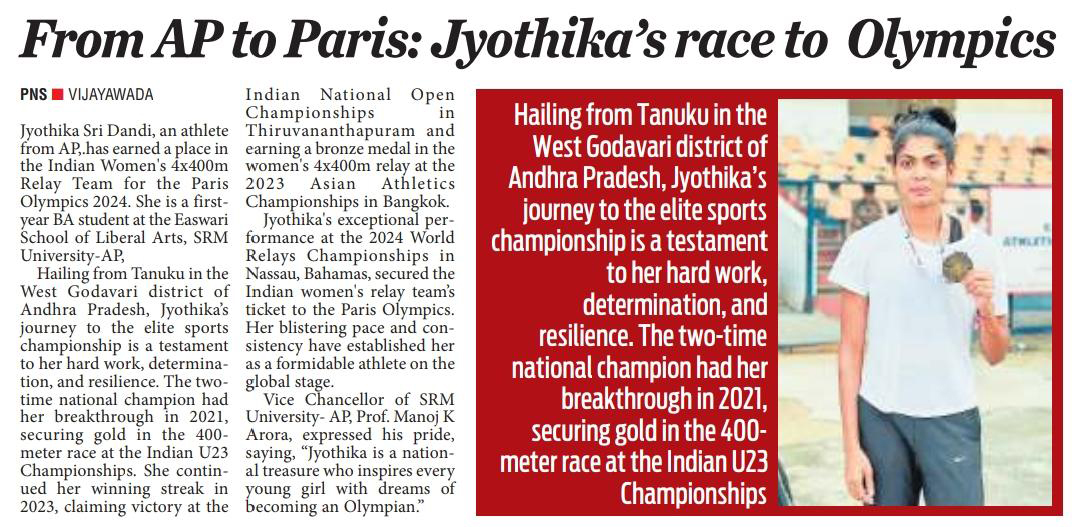
Eenadu
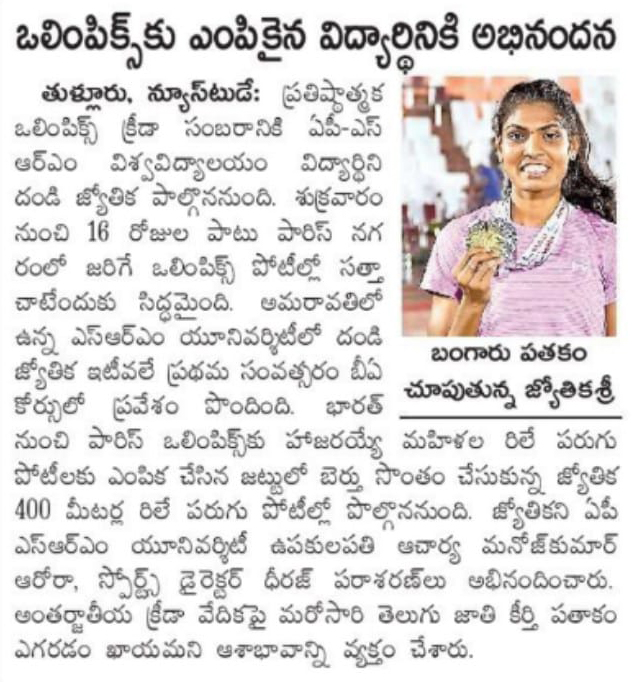
Vartha

Sakshi

Andhraprabha

Visalaandhra
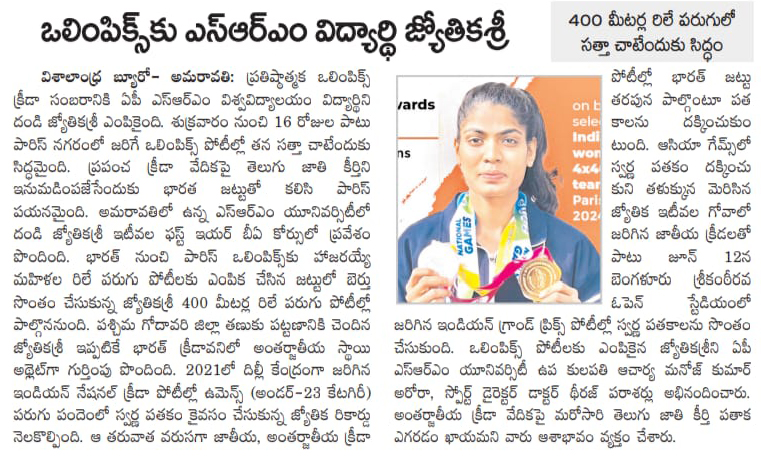
Andhra Patrika
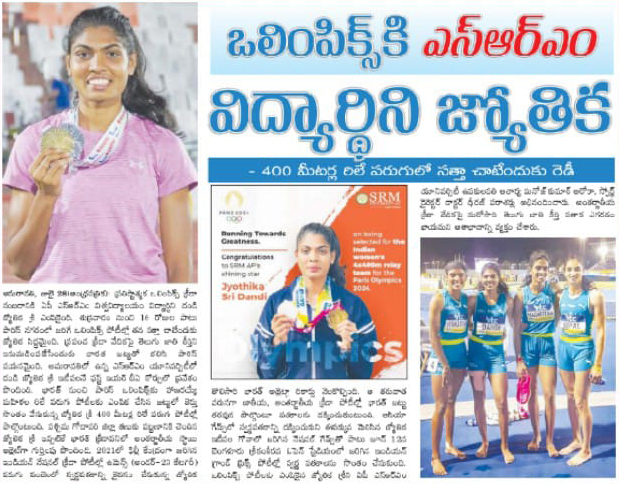
Paalana Daily

Seema ratnam News

Disha Daily
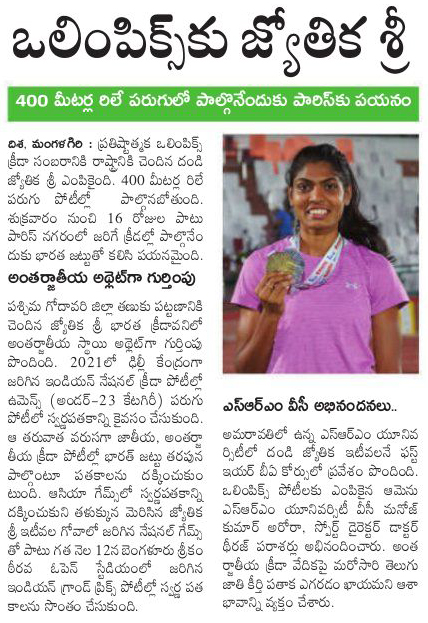
- Dr Raviteja K Publishes Book on Sustainable Materials in Civil Infrastructure July 29, 2024
 Dr Raviteja K, Assistant Professor in the Department of Civil Engineering, has recently authored a groundbreaking book entitled “Sustainable Materials in Civil Infrastructure.” This publication is set to become a valuable resource for professionals and students in the field, shedding light on the importance of sustainable practices in construction and infrastructure development. His expertise and dedication to promoting environmentally friendly solutions within the realm of civil engineering have culminated in this significant literary contribution. The book delves into the utilization of eco-conscious materials, innovative construction techniques, and the crucial role they play in creating a more sustainable future for infrastructure projects worldwide.
Dr Raviteja K, Assistant Professor in the Department of Civil Engineering, has recently authored a groundbreaking book entitled “Sustainable Materials in Civil Infrastructure.” This publication is set to become a valuable resource for professionals and students in the field, shedding light on the importance of sustainable practices in construction and infrastructure development. His expertise and dedication to promoting environmentally friendly solutions within the realm of civil engineering have culminated in this significant literary contribution. The book delves into the utilization of eco-conscious materials, innovative construction techniques, and the crucial role they play in creating a more sustainable future for infrastructure projects worldwide.His work is anticipated to inspire a new wave of sustainable practices in the industry and drive positive change towards greener and more resilient civil infrastructure development. Congratulations to Dr. Raviteja K on this remarkable achievement that is sure to make a lasting impact in the field of civil engineering!
Publication details (incl. Publisher, ISBN, Launch date, Edition, etc):
Title: Sustainable Materials in Civil Infrastructure, Publisher: Elseveir, ISBN: 978-0-443-16142-1, Date: July 2024, doi: https://doi.org/10.1016/C2022-0-02477-6.Brief Introduction the Book:
Sustainable Materials in Civil Infrastructure delves into cutting-edge advancements in eco-materials, offering solutions crucial for building resilient and sustainable infrastructure. It provides profound insights into pioneering research on eco-materials for construction, offering a comprehensive guide on recycled steel, low-carbon concrete, bioconcrete, self-healing concrete, and industrial by-products like fly ash and shape memory alloys. Chapters explore design applications of bioconcrete and the utilisation of eco-materials in landfill liners and masonry, while also addressing obstacles hindering the widespread adoption of green concrete and bioconcrete, proposing practical solutions. This book serves as a cornerstone for the development of sustainable design methodologies, embraced by environmental monitoring bodies worldwide.Significance of Book
The book “Sustainable Materials in Civil Infrastructure” published by Elsevier is a pivotal resource in the field of sustainable engineering, particularly relevant to my work in developing solutions for geotechnical and geoenvironmental challenges at Sustainable Engineering Research Laboratory (SERL), SRM University AP.The inclusion of topics such as bioconcrete and the utilization of eco-materials in landfill liners and masonry is particularly significant. Bioconcrete, for instance, exemplifies a pioneering approach by integrating biological processes into construction materials, thereby promoting sustainability and durability. Addressing obstacles to the widespread adoption of green concrete and bioconcrete is also crucial, as it underscores the practical challenges that need to be overcome for these materials to achieve mainstream acceptance.
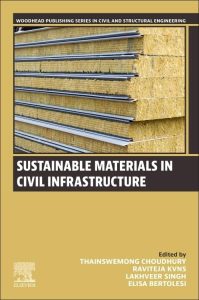
For my research focus at SERL, this book serves as a cornerstone. It not only provides in-depth insights into the latest research and development in sustainable materials but also offers practical guidance on their design applications and integration into infrastructure projects. Moreover, the emphasis on sustainable design methodologies aligns perfectly with our laboratory’s mission to promote environmentally conscious practices in civil engineering.
Target Audience of the Book
The target audience of the book “Sustainable Materials in Civil Infrastructure” includes a wide range of professionals and researchers involved in civil engineering, sustainability, and materials science. Specifically, the book would be helpful and resourceful for:
Civil Engineers, Researchers and Academics, Environmental Engineers, Policy Makers and Regulatory Bodies, Students, Construction Industry Professionals, and Consultants.Co-authors
The co-editors include: Thainswemong Choudhury, Lakhveer Singh and Elisa BertolesiThe Link of the Book Publication
Continue reading → - Innovation Alert: Patent on Plant Disease Detection Published by CSE Team July 29, 2024
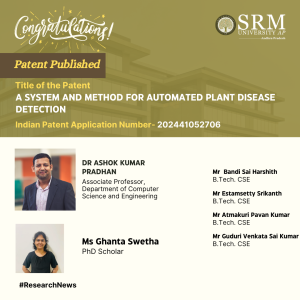 In an impressive achievement, Dr Ashok Kumar Pradhan, Associate Professor of the Department of Computer Science and Engineering, along with PhD Scholar Ms Ghanta Swetha and BTech CSE students Mr Bandi Sai Harshith, Mr Estamsetty Srikanth, Mr Guduri Venkata Sai Kumar, and Mr Atmakuri Pavan Kumar, has successfully published a patent titled “A SYSTEM AND METHOD FOR AUTOMATED PLANT DISEASE DETECTION.” The application has been officially recognised with Application Number: 202441052706, as recorded in the Patent Office Journal.
In an impressive achievement, Dr Ashok Kumar Pradhan, Associate Professor of the Department of Computer Science and Engineering, along with PhD Scholar Ms Ghanta Swetha and BTech CSE students Mr Bandi Sai Harshith, Mr Estamsetty Srikanth, Mr Guduri Venkata Sai Kumar, and Mr Atmakuri Pavan Kumar, has successfully published a patent titled “A SYSTEM AND METHOD FOR AUTOMATED PLANT DISEASE DETECTION.” The application has been officially recognised with Application Number: 202441052706, as recorded in the Patent Office Journal.This innovative system aims to revolutionise the agricultural sector by providing an automated mechanism for detecting diseases in plants. Thus, it enhances crop management and ensures healthier yields. The team’s dedication to advancing technology and improving agricultural practices showcases the potential of computer science in solving real-world problems.
The patent not only reflects the hard work and collaboration among the faculty and students but also signifies a step forward in the integration of technology with agriculture. As the world faces challenges related to food security, such innovations play a critical role in safeguarding plant health and agricultural productivity.
Congratulations to Dr Pradhan, Ms Swetha, and the student inventors on this significant milestone in their academic and professional endeavours!
Abstract of the Research:
The innovation that is being presented in this project is a software-based system that is intended to help farmers by offering an automated way to identify plant diseases. This innovation combines a number of technological elements:Convolutional Neural Networks (CNNs): These networks are used to recognise and categorise plant diseases from images of both healthy and sick plants with high accuracy. This is leveraging transfer learning with pre-trained CNN architectures to improve performance even with sparsely annotated data.
MobileNetV2 Architecture: Designed with the specific purpose of classifying agricultural diseases in mind, this model is effective and lightweight, making it ideal for use in resource- constrained settings such as farms.
Weather API Integration: This helps farmers make decisions about crop management and disease prevention by giving them access to real-time weather data.
AI-Powered Website: Acts as a user interface for farmers to communicate with the system, submit plant photos, post queries, and get weather and diagnostic updates.
Chatbot: Utilizes Recurrent Neural Networks (RNN) and Natural Language Processing (NLP) to respond to user inquiries and provide guidance on crop management and disease prevention.
All things considered, this innovation is a system that integrates various software components, artificial intelligence, and data integration to produce a complete tool for raising agricultural productivity and managing diseases.
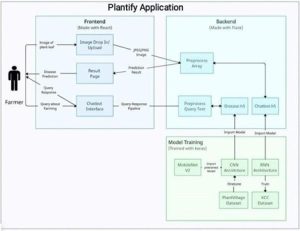
Research in Layperson’s Terms
1. Automated Plant Disease Prediction: Current approaches frequently use traditional diagnostic procedures and manual inspection, which can be laborious and prone to human mistakes. The suggested method uses CNNs to automatically and precisely recognise images, increasing the efficacy and precision of plant disease diagnosis.
2. This project assists farmers in making decisions on crop management and disease prevention by providing them with access to current weather information.
3. Farmers can query various farming issues and receive responses. This is done by leveraging RNNs and NLP.
4. Use of Transfer Learning: The system uses transfer learning to use pre-trained CNN architectures, which enables it to function well even with a small amount of annotated data. Compared to typical machine learning models, which frequently need big datasets and intensive training, this is a major improvement.
Integration with Smart Agriculture Systems: – This method combines disease prediction with smart agriculture systems, allowing for real-time monitoring and decision-making, in contrast to independent diagnostic instruments.Practical Implementation or the Social Implications Associated
1. Field Diagnosis by Farmers: – Farmers can snap photos of their crops in the fields and instantly receive a disease diagnosis and treatment suggestions by using the platform.2. Agricultural Extension Services: Using the system, agricultural extension agents may help farmers more effectively by offering guidance and support.
3. Agricultural Research: – Researchers can investigate plant diseases and create novel remedies and management techniques by utilizing the extensive annotated picture library and diagnostic tools.
4. Commercial Farming Operations: – By incorporating the system into their precision agriculture techniques, large-scale farming operations can maximize crop health management and operational effectiveness.
5. Policy Formation and Governance: – Governmental organizations can monitor plant disease outbreaks and create regional or national plans for disease control and prevention using aggregated data from the platform.
Future research plans
We may use privacy and security enhancement tools and techniques to make the data more secure
Continue reading → - Budget 2024 Boosts Entrepreneurship: Tarun Scheme Expansion and Fiscal Discipline July 26, 2024
The Savera Times
Continue reading →
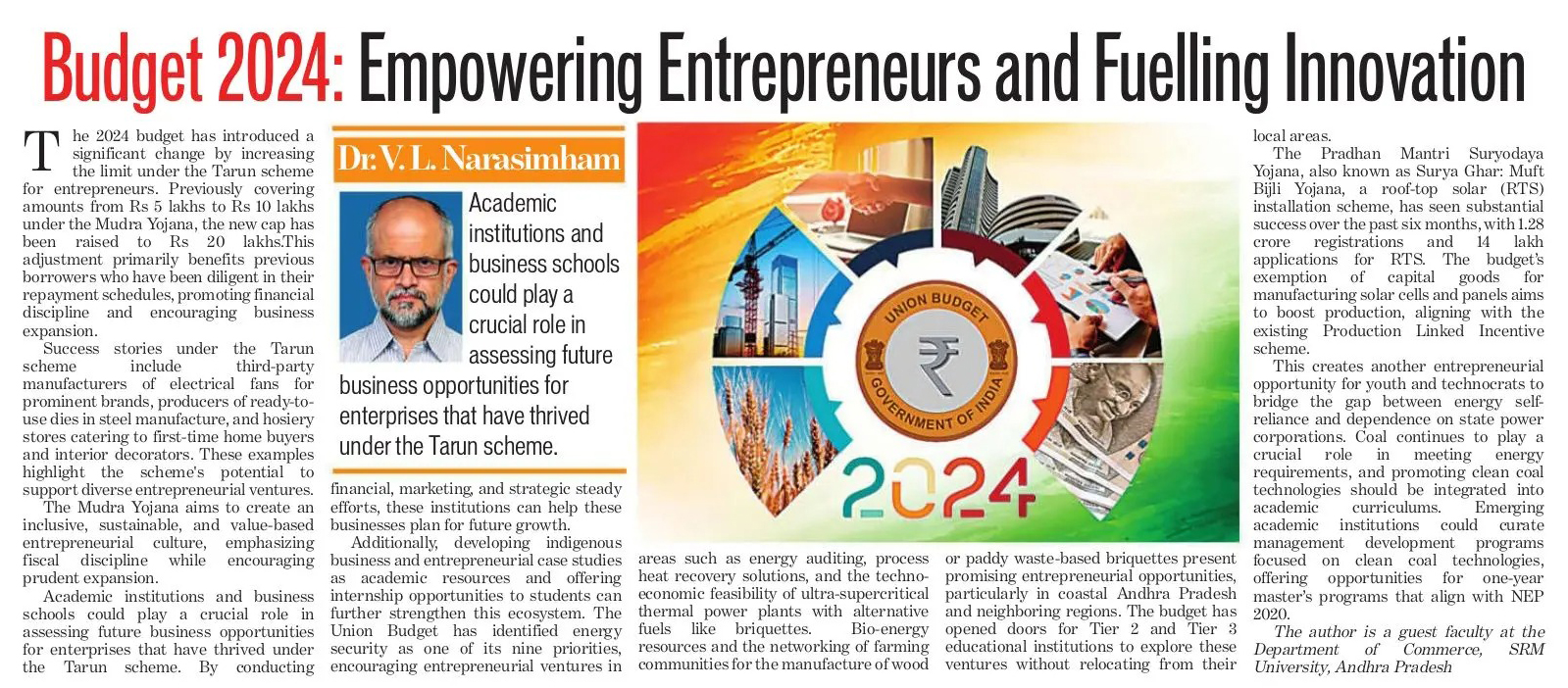
Dainik Savera

- Dimpal Janu July 26, 2024

